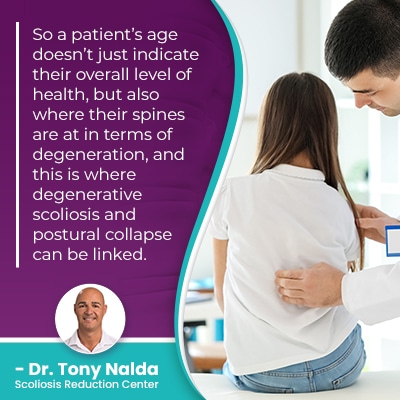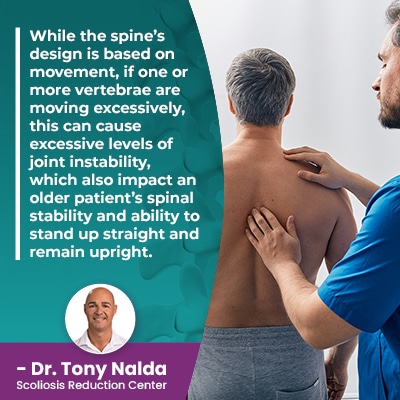Can Scoliosis Cause Legs To Collapse While Standing?

As scoliosis is a structural spinal condition and its effects can be felt throughout the body, many people wonder if postural collapse can be a related complication of scoliosis. Continue reading to understand some of the condition’s main effects, and which age group is most likely to experience postural collapse.
Scoliosis causing the legs to collapse while standing isn’t a common condition effect, particularly in the most prevalent form of scoliosis: adolescent idiopathic scoliosis. In degenerative scoliosis, however, that affects older adults, this is more possible.
As there are different severity levels and types of scoliosis, let’s talk about how scoliosis is diagnosed and classified, before moving on to how scoliosis affects different age groups.
Table of Contents
Diagnosing and Classifying Scoliosis
When it comes to diagnosing and classifying scoliosis, not only does scoliosis involve the development of an unnatural spinal curve, the spine also rotates, making it a 3-dimensional spinal condition.
Part of diagnosing scoliosis involves further classifying conditions based on key patient/condition variables, and these include patient age, condition severity, curvature location, and type.
When it comes to whether postural collapse is possible, patient age, condition severity, and type are important factors.
As the spine allows us to stand upright, practice good posture, and gives the body structure, it’s natural to wonder if having an unnatural spinal curvature could cause a person’s legs to collapse while standing for extended periods of time.
Condition severity ranges from mild to moderate and severe to very severe, and condition effects are going to be more noticeable the more severe a patient’s condition is, and this is determined by a measurement known as Cobb angle.
- Mild scoliosis: Cobb angle measurement of between 10 and 25 degrees
- Moderate scoliosis: Cobb angle measurement of between 25 and 40 degrees
- Severe scoliosis: Cobb angle measurement of 40+ degrees
- Very-severe scoliosis: Cobb angle measurement of 80+ degrees
So let’s talk about the factors that shape a patient’s experience of life with scoliosis.
Condition Type and Patient Age
Condition type and patient age are key condition/patient variables, but condition type is determined by a condition’s underlying cause, when known.
Now, the vast majority of scoliosis cases are classified as idiopathic, meaning not clearly associated with a single-known cause; in fact, in 80 percent of cases, we don’t know what triggered the initial onset of scoliosis, and the remaining 20 percent are associated with known causes.
 Scoliosis with known causes includes neuromuscular scoliosis, congenital scoliosis, and degenerative scoliosis.
Scoliosis with known causes includes neuromuscular scoliosis, congenital scoliosis, and degenerative scoliosis.
Neuromuscular scoliosis is caused by the presence of a larger neuromuscular condition such as cerebral palsy, spina bifida, and muscular dystrophy.
Congenital scoliosis is a rare form, affecting approximately 1 in 10,000, and is caused by a malformed spine that develops in utero; babies are born with the condition.
The most prevalent condition-type overall is adolescent idiopathic scoliosis, diagnosed between the ages of 10 and 18, and this age group is at risk for rapid-phase progression because the condition’s main trigger for getting worse is growth, and puberty is characterized by rapid and unpredictable growth spurts.
Adolescents, however, are not as at risk for postural collapse because even if the spine curves unnaturally to the side, it can still be stable in young patients who have not yet started to experience natural age-related spinal degeneration.
In addition, scoliosis doesn’t become a compressive condition until adulthood has been reached, and it’s compression of the spine and its surrounding muscles and nerves that causes the majority of condition-related pain and many condition-effects.
If scoliosis is left untreated, its effects are likely to become more noticeable, and this can also include the development of related complications such as digestive issues, lung impairment, and migraines due to irregular cerebrospinal fluids in and around the brain.
So a patient’s age doesn’t just indicate their overall level of health, but also where their spines are at in terms of degeneration, and this is where degenerative scoliosis and postural collapse can be linked.
Degenerative Scoliosis and Postural Collapse
Degenerative scoliosis is diagnosed in older adults, commonly over the age of 50, and is caused by natural age-related spinal degeneration.
The cumulative effect of certain lifestyle choices can also contribute to a patient’s level and rate of natural spinal degeneration: carrying excess weight, leading a sedentary lifestyle, chronic poor posture, excessive consumption of alcohol and/or smoking, and repeatedly lifting heavy objects incorrectly and straining the spine.
In most instances of spinal degeneration, it’s the spine’s intervertebral discs that are the first structures to feel the effects of deterioration, and the discs have many important roles in maintaining spinal health and function.
The spine consists of vertebrae (bones) stacked on top of one another in a straight and neutral alignment, and adjacent vertebrae are separated by an intervertebral disc that provides the spine with structure (adjacent vertebrae attach to the disc in between), cushioning, flexibility, and act as the spine’s shock absorbers.
If one or more spinal discs start to deteriorate, they tend to become desiccated and lose height, changing shape as a result, and this shifts the position of adjacent vertebrae, and can cause the development of an unnatural spinal curve.
 As the spine’s discs deteriorate, the spine becomes unstable, and as spinal degeneration tends to increase with age, this is the condition type with the most potential to cause postural collapse that involve the legs giving in while standing for extended periods of time; however, this still isn’t a common condition-effect, but is more likely associated with severe forms of degenerative scoliosis.
As the spine’s discs deteriorate, the spine becomes unstable, and as spinal degeneration tends to increase with age, this is the condition type with the most potential to cause postural collapse that involve the legs giving in while standing for extended periods of time; however, this still isn’t a common condition-effect, but is more likely associated with severe forms of degenerative scoliosis.
While the spine’s design is based on movement, if one or more vertebrae are moving excessively, this can cause excessive levels of joint instability, which also impact an older patient’s spinal stability and ability to easily stand up straight and remain upright.
What Are the Main Effects of Scoliosis?
In young patients who are still growing, the condition is not yet compressive, so pain isn’t a common part of childhood scoliosis; in children, the condition’s main symptoms involve postural deviation caused by a disruption to the body’s overall symmetry.
In many cases, the condition’s earliest signs in children are uneven shoulders, hips, and the development of a rib arch.
In adults, the main condition effect is pain, and this is what brings the majority of adults in for a diagnosis and treatment.
When the spine stops growing, there is no longer a lengthening motion to counteract the compressive force of the unnatural spinal curve, and this makes the spine and its surrounding muscles and nerves vulnerable to compression.
Adults will also experience postural changes such as a prominent lean to one side, and these types of postural changes are most noticeable when in a forward-bend position.
In cases of degenerative scoliosis that are left untreated, increasing spinal and joint instability can cause the potential effect of postural collapse, particularly when severe, and/or during extended periods of standing, but again, this isn’t a common effect or occurrence.
When degenerative scoliosis is treated proactively, a curvature reduction can be worked towards along with improving disc health and increasing spinal stability.
In cases of degenerative scoliosis, the goal is to reduce the size of the scoliotic curve back to where it was prior to becoming painful.
Conclusion
When people are diagnosed with scoliosis, they, understandably, have a lot of questions.
Naturally, people want to know how bad the condition can get, what caused it, and what types of symptoms and effects they should expect.
When it comes to postural collapse and the inability to remain standing for extended periods of time, this isn’t a common effect or complication of scoliosis, particularly when not severe and/or when treated proactively.
In severe cases of degenerative scoliosis that affect aging adults, postural collapse is more likely because spinal instability becomes an issue, and if left untreated, age-related spinal degeneration does tend to increase with age and can make the spine increasingly unstable over time.
The best way to minimize the condition’s potential effects is to proactively work towards preventing progression and reducing the size of the scoliotic curve as this addresses its underlying structural nature and also reduces the condition’s uneven forces.
Here at the Scoliosis Reduction Center, I start treatment as close to the time of diagnosis as possible because in younger patients, I have to work towards counteracting the condition’s progressive nature during growth, and in adults with degenerative scoliosis, I have to work towards improving spinal stability and preserving spinal strength and function.
Dr. Tony Nalda
DOCTOR OF CHIROPRACTIC
After receiving an undergraduate degree in psychology and his Doctorate of Chiropractic from Life University, Dr. Nalda settled in Celebration, Florida and proceeded to build one of Central Florida’s most successful chiropractic clinics.
His experience with patients suffering from scoliosis, and the confusion and frustration they faced, led him to seek a specialty in scoliosis care. In 2006 he completed his Intensive Care Certification from CLEAR Institute, a leading scoliosis educational and certification center.
About Dr. Tony Nalda
 Ready to explore scoliosis treatment? Contact Us Now
Ready to explore scoliosis treatment? Contact Us Now





